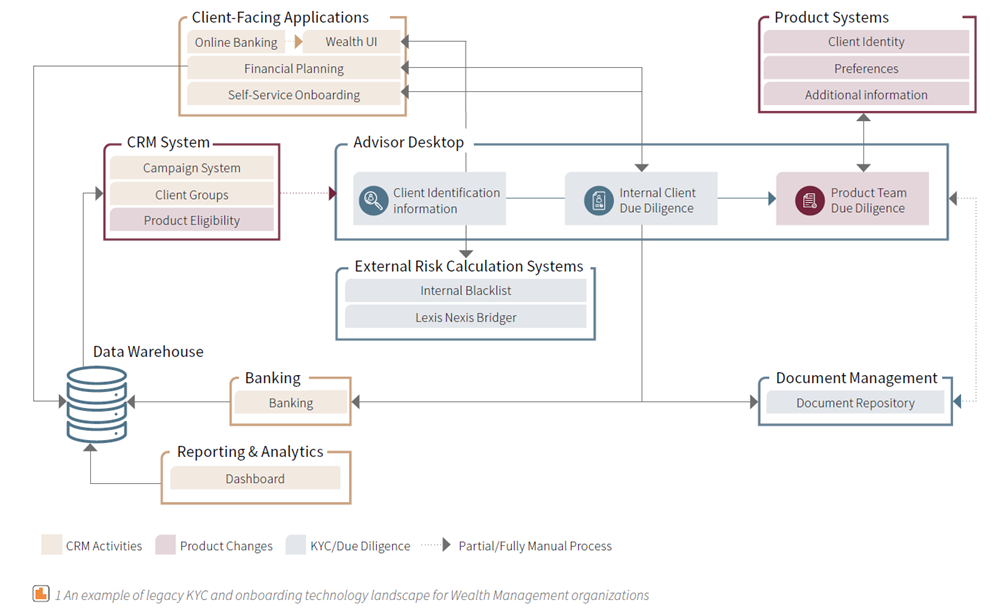Financial institutions are under growing regulatory pressure to design adequate KYC processes. However, their efforts are often hampered by antiquated, disconnected systems and lengthy procedures that exponentially increase chances of error. With the risk of fines, lost revenue and sheer wasted effort, the cost is exorbitant. A smart, lean KYC process can reduce the losses and enhance compliance.
Financial institutions globally faced $10.4 billion in fines for anti-money laundering (AML), know your client (KYC), data privacy and MiFID (Markets in Financial Instruments Directive) violations in 20201, a 26% increase from the previous year. With the industry remaining under scrutiny and subject to evolving regulations, banks must become proactive with their systems by prioritising digital transformation in crucial areas of service provision to reduce additional fines. We see many wealth managers in the industry recognising this trend and looking to enhance their KYC data collection and review process that improves customer experience and ensures sustained compliance. Synpulse has partnered with vendors and key client stakeholders to design and implement a rule-based KYC process that requires employees to provide client due diligence data based on just three attributes: client risk, account type requested, and ownership structure. This can bring down KYC processing times significantly.
[1]Approximately $4.3 billion worth of fines were levied on financial institutions headquartered out of the US alone. ‘Global Financial Institution Fines for AML, Data Privacy and MiFID Rise 26% in 2020’ Fenergo December 9th, 2020
Background & Challenges
In Synpulse’s experience, large financial organisations continue to face KYC compliance issues because of their traditional approach of tying client data to the account being opened. In simple terms, this has meant that almost identical client information is collected separately by each product team as they go through the account opening process in silos, resulting in data duplication for the same client. In addition, this data is not stored in any centralised location accessible to all relevant teams across the firm (legal, product teams, marketing etc.). As a result, client experience is negatively impacted when representatives from various teams within the organisation present repeated data requests for every new type of product a client asks for. Periodically this inefficiency results in a loss of revenue for the firm.
The lack of a golden source of data is also problematic as regulatory bodies continue to reinforce periodic reviews of client information as a part of ongoing risk mitigation and transaction tracking. Because teams continue to maintain their records individually and on rudimentary systems, the organisation is unable to track and report on KYCs that are due for review in the year based on their original risk rating. In some cases, this creates overdue records with incomplete data, opening organisations up to additional regulatory fines and reputational risk.
Disjointed Technology Landscapes
The process is made lengthier by the multiple, disconnected systems that teams must engage with to process parts of the KYC. Large financial institutions that are still in the early stages of their transformation continue to stitch together client information through various unintegrated systems within their technology landscape: latest KYC-related document templates must be downloaded from internal sites and filled manually, client information submitted to another third-party software to calculate the risk rating, ad hoc media searches done on web browsers and final approvals acquired by attaching the documentation and rating to an email. Inevitably, critical items slip through the cracks, and KYC documentation is seldom up to par for reviewers. Many organisations have undergone extensive data remediation exercises to address the data gaps on file. However, as long as the underlying issue of a fragmented technology landscape persists, organisations will continue to face external scrutiny and internal wastefulness. Simultaneously, firms are likely to lose potential revenue because of clients who require enhanced due diligence, or because the company inadequately assesses the risk that a client is bringing, exposing the institution to outsized brand damage.

Finally, limited channels of approval for high-ranking bankers create a bottleneck for officers trying to expedite the KYC review to meet quick turnaround times for client transaction requests. Most legacy databases and basic onboarding tools usually provide approvals through the organisation’s desktop, with only a small number of organisations allowing emails as acceptable approvals. In almost all cases, approvals can be issued to only one individual at a time. Consequently, on days when managing directors and senior bankers are unable to get to their desks or their inboxes (e.g. when on MTAs), KYCs and reviews continue to be held up. This increases the overall cycle time for KYC processing and results in poorer customer experience.
Regulatory Compliance: Stakeholder Management and Training
In situations where data centraliation system streamlining is already being addressed, our experience has revealed a limited understanding of the evolving regulatory changes in the field. The status quo when it comes to tracking the current relevant KYC requirements for any new client is usually a static document that the field office is inevitably the last to receive. This results in higher KYC rejections by internal compliance officers during reviews, which in turn frustrate bankers and clients alike. Anecdotally, we have also witnessed a large percentage of rejections because of incorrectly typed data or common human errors that weren’t caught before KYC submissions to the reviewer because of a lack of systemic platform validations.
It should be noted that many pertinent regulations only provide reviewers and organisations with parameters for compliance; legal teams within each organisation then decide on how these parameters are best implemented in their procedures, business rules and technology platforms to ensure compliance. In such cases, continuous training, change management and communication are crucial to ensure that all relevant stakeholders understand the organisation’s interpretation of the new regulations to produce high quality KYC applications and reviews. Unfortunately, in many cases, this has been an afterthought for organisations due to a lack of funding. As a result, even with state-of-the-art systems, financial institutions continue to face similar issues as employees are slow to fully adopt new technologies and stay abreast with any new guidelines issued at the grassroots level.
Synpulse’s Impact
As a trusted implementation partner for our clients, Synpulse has delivered solutions that harmoniously combine KYC and data collection processes, as well as builds employee confidence in the solution that fully integrates with upstream and downstream systems.
Using our extensive global knowledge and experience, we have identified key areas where the most common pain points that the banking industry faces during the KYC process lie. This framework helps inform our gap assessment for each client to ensure a truly tailored solution that sits comfortably within the organisation’s digital landscape and adds business value.
Continue reading & download our approach including detailed framework. Click here to learn more.

